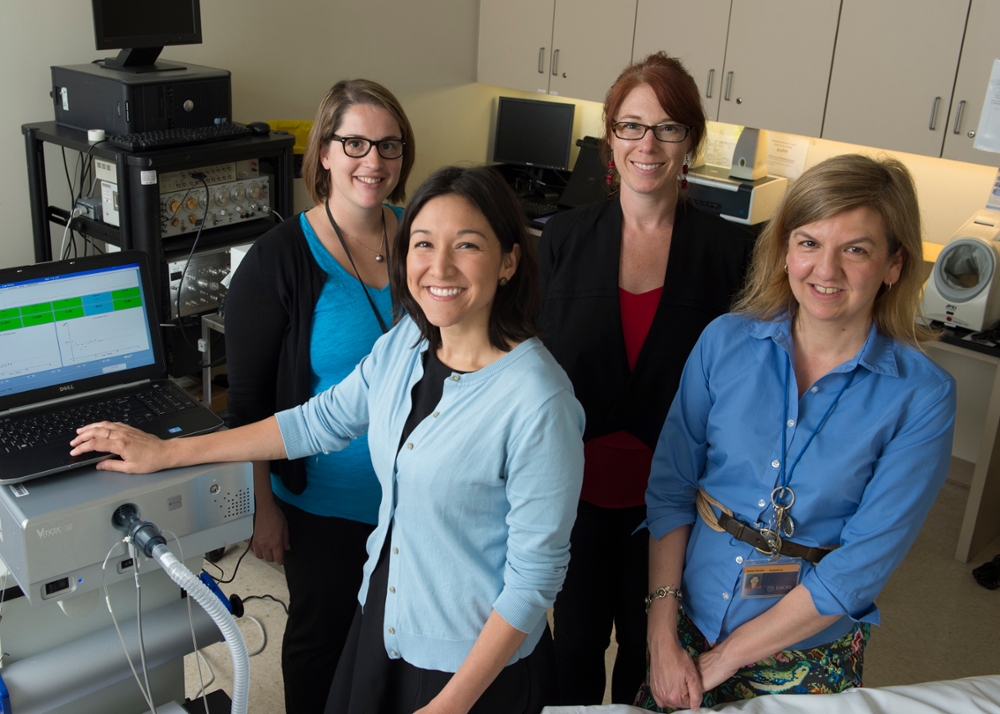ACTSI Investigators Find Association between Excess Adiposity and Lower Lung Function in Adults with Cystic Fibrosis

LtoR: Jessica Alvarez, Erin Millson, Wendy Hermes, and Elizabeth Ivie
In a recent study published in the journal, Nutrition, Atlanta Clinical & Translational Science Institute (ACTSI) investigators Jessica A. Alvarez, PhD, RD, Thomas R. Ziegler, MD, Erin C. Millson, MS, RDN, and Arlene A. Stecenko, MD, found that excess body fat was associated with lower lung function among adults with cystic fibrosis (CF).
Cystic fibrosis is a fatal inherited disease, which results in progressive declines in lung function and impairments to the digestive system. However, with the life expectancy of CF patients increasing well into adulthood, nutritional interventions are of increasing importance to optimize the health of this population. Traditionally, nutrition interventions in CF have focused on increasing or maintaining an individual’s body mass index (BMI). BMI is a measure of the size of an individual, derived solely from height and weight measurements; it does not describe the composition of body fat (adiposity) relative to fat-free components (such as bone or muscle). One may have a normal BMI but have a high body fat percentage, a characteristic termed “normal weight obesity (NWO).” In non-CF populations, excess adiposity has been associated with lower lung function; however, few studies have examined the prevalence and impact of NWO in CF.
To investigate the relationship between body composition and lung function in adults with CF and to examine the specific presence of NWO in this CF population, the authors enrolled 32 adults with CF from the Emory Adult Cystic Fibrosis Program clinic along with a reference group of 20 generally healthy adults without CF. All testing for the study took place in the Georgia CTSA Clinical Research Centers (GCRCs) Clinical Research Site at Emory University Hospital. Body composition was measured using an instrument called the BOD POD® which uses air displacement in a closed chamber to calculate percent body fat, total fat mass, and total fat-free mass. Normal weight obesity was defined as a BMI less than 25 kg/m2, with a percent body fat of greater than 30% for women and greater than 23% for men. Lung function was determined using the percentage of predicted forced expiratory volume in one second (FEV1% predicted).
The authors found that despite having lower height, weight, BMI, and fat-free mass than the healthy reference group, there was no difference between adults with CF and the reference group in percent body fat or total fat mass, suggesting a possible preferential depletion of fat-free mass in CF disease. In examining the relationship between body composition and lung function in adults with CF, the authors found that a one percentage point increase in percent body fat was associated with 1.42 percentage point decrease in lung function (FEV1% predicted). Thirty one percent of CF patients were found to have NWO, and those with NWO had lower lung function compared to those without NWO. “These findings suggest that excess adiposity relative to body size is associated with lower lung function in adults with CF,” said lead author Jessica Alvarez, assistant professor of medicine at the Emory University School of Medicine and ACTSI Certificate Program in Translational Research (CPTR) associate director. “We push to increase or maintain a specific BMI in patients with CF, but usually don’t measure their body fat or muscle, which could be a more important determinant of health. While further research is needed, nutrition monitoring protocols in CF may need to be modified to include measures beyond BMI.”
This work was supported in part by grants from the Cystic Fibrosis Foundation and the National Institutes of Health (NIH). The investigators utilized the nursing, laboratory, and bionutrition resources in the GCRC. “Nursing and Laboratory helped us with the blood draws and samples processing. The Bionutrition Unit was critical to the success of the study as they helped us with body composition testing using the BOD POD,” said Alvarez.
The Georgia CTSA Clinical Research Centers (GCRCs) is a multilayered, flexible, and geographically distributed network created to meet the needs of translational and clinical investigators from Emory, Morehouse School of Medicine (MSM), and Georgia Institute of Technology (Georgia Tech). The GCRCs includes nearly 35 clinical research sites across the city incorporating hospital, medical office, and community-based clinical research sites, such as Emory University Hospital, Emory Midtown Hospital, Grady Memorial Hospital, Children’s Health Care of Atlanta, the Ponce Infectious Diseases Clinic, the Hope Clinic, Wesley Woods Health Center, and the Morehouse School of Medicine Clinical Research Center.
The ACTSI is a city-wide partnership between Emory, MSM, and Georgia Tech and is one of over 60 in a national consortium striving to improve the way biomedical research is conducted across the country. The consortium, funded through the National Center for Advancing Translational Sciences (NCATS) and the National Institutes of Health’s Clinical and Translational Science Awards, shares a common vision to translate laboratory discoveries into treatments for patients, engage communities in clinical research efforts, and train the next generation of clinical investigators.